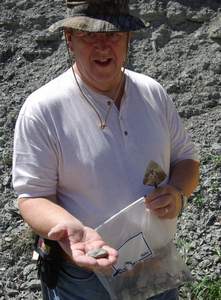
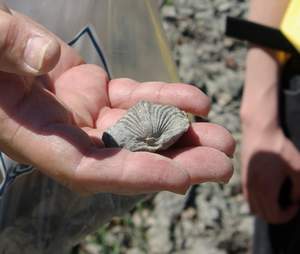
In April, the Dry Dredgers returned to an old favorite site that exposes the Bellevue Formation east of Cincinnati, Ohio. In the old days of the 90's, it yielded buckets of the large brachiopod Vinlandostrophia ponderosa. But by the turn of the century, the road cut had become picked over. Perhaps we had made it too well known.
We first revisited this site during our push to revisit old sites in April 2008. We found so many nice things, we decided to return this year. Keep this site a secret, okay?. We don't want it to get too picked over again.
It wasn't too picked over this time. Below you will see our Vice President, Rich Fuchs, sporting the main attraction, Vinlandostrophia ponderosa.
The weather was great. Perfect for collecting fossils. The turnout was fine, but a bit light compared to some trips. There were two sites on the itinerary that day, but almost everyone stayed at the first site until they were exhausted.
Fossils Found That Day
This site exposes the Bellevue Formation and some of the Corryville Formation. These formations are part of the Maysvillian stage of the Cincinnatian Series. The age is about 445 million years old. That's how long ago these animals were alive.
We had waited long enough since the last trip that weathering yielded more good quantities of the large Brachiopod, Vinlandostrophia ponderosa.
Even though lots of Vinlandostrophia were free from the rock and
look as though they were cleaned, almost every rock was loaded with large
brachiopods (next two pics).
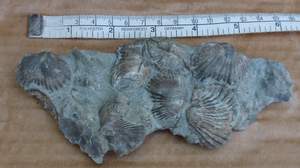
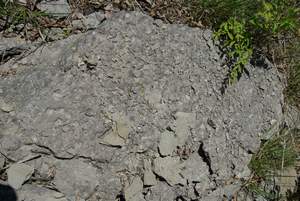
Some Vinlandostrophia were not as easy to spot in
the matrix. Can you find the brachiopod in the next 3 pictures?
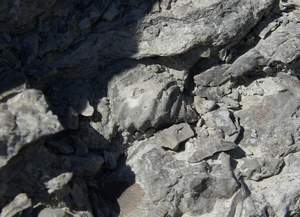
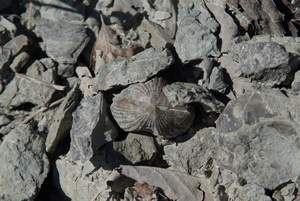
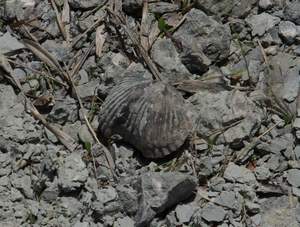
Another species besides ponderosa that were found in good quantity was Vinlandostrophia laticosta.(next 2 pics).
The next most common brachiopod found on that site was the
very beautiful Hebertella occidentalis.
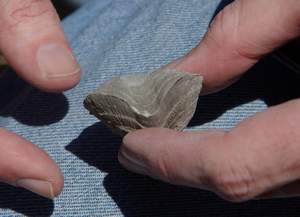
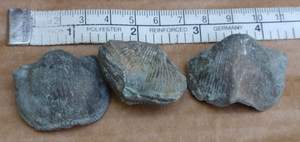
On the average, I think one Hebertella was found for every
handful of Vinlandostrophia, as shown in the next photos.
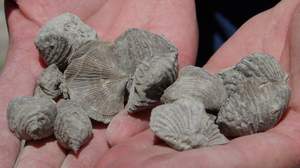
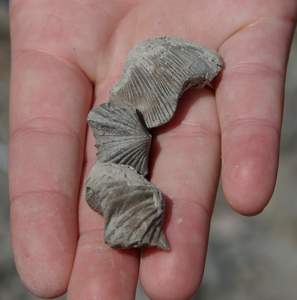
Another common brachiopod we found was Rafinesquina
ponderosa.
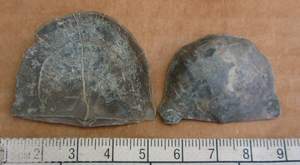
What is most interesting about Rafinesquina, is that they have a large surface that is host to all kinds of epizoans (attaching animals). Here is a photo and a closeup of an inarticulate brachiopod on a Rafinesquina. This inarticulate is called Petrocrania scabiosa. Note in particular on the close-up, that this specimen has lines running in a different direction to the plications of the Rafinesquina. Perhaps the Petrocrania was following the growth lines of the Rafinesquina, or perhaps the other encrusters on the surface you see there made an impression on the Petrocrania. The other encrusters are bryozoans, some of them are cyclostomate bryozoa.
A different species we found was Rafinesquina nasuta. This
species is limited to the Corryville Formation, which was above the layers we
were examining on the road cut.
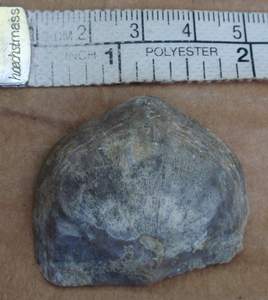
Bryozoans
Pelecypods or Bivalves (clams)
Nautiloid Cephalopods
Trilobites
Flexicalymene
Isotelus
Gastropods (snails)
A parting group shot.
That's it for the April field trip. In May, we visited the famous Mt. Orab, Ohio trilobite farm!
Back to the Field Trip Photo Index
Return to Dry Dredgers Home Page
The Dry Dredgers and individual contributors reserve the rights to all information, images, and content presented here. Permission to reproduce in any fashion, must be requested in writing to admin@drydredgers.org .